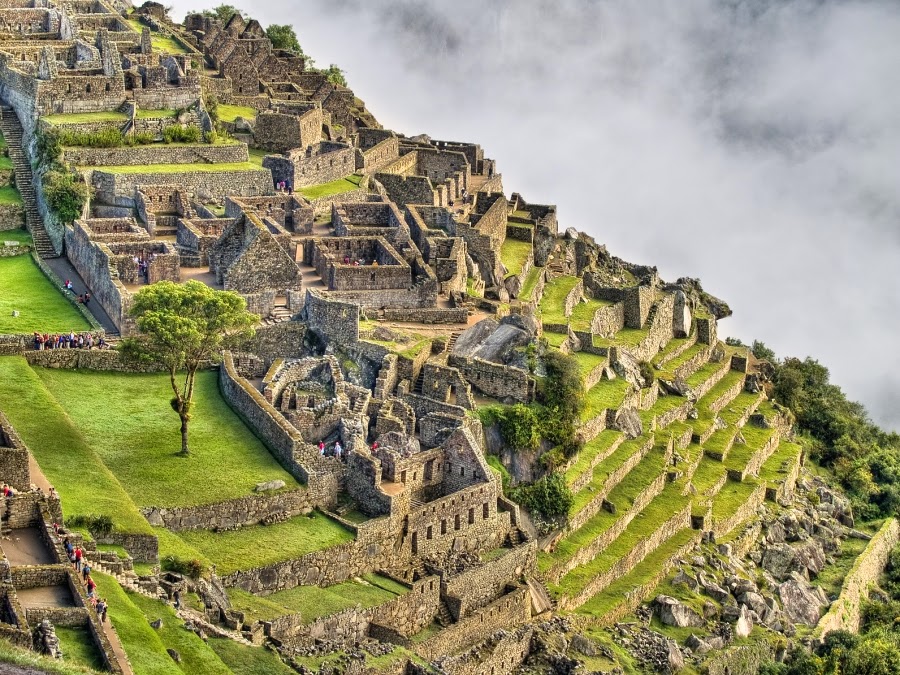 Machu Picchu stands 2,430 m above sea-level, in the middle of a tropical mountain forest, in an extraordinarily beautiful setting. It was probably the most amazing urban creation of the Inca Empire at its height; its giant walls, terraces and ramps seem as if they have been cut naturally in the continuous rock escarpments. The natural setting, on the eastern slopes of the Andes, encompasses the upper Amazon basin with its rich diversity of flora and fauna.
Machu Picchu stands 2,430 m above sea-level, in the middle of a tropical mountain forest, in an extraordinarily beautiful setting. It was probably the most amazing urban creation of the Inca Empire at its height; its giant walls, terraces and ramps seem as if they have been cut naturally in the continuous rock escarpments. The natural setting, on the eastern slopes of the Andes, encompasses the upper Amazon basin with its rich diversity of flora and fauna.  The Incas started building the “estate” around AD 1400, but abandoned it as an official site for the Inca rulers a century later at the time of the Spanish Conquest. Although known locally, it was unknown to the outside world before being brought to international attention in 1911 by the American historian Hiram Bingham.
The Incas started building the “estate” around AD 1400, but abandoned it as an official site for the Inca rulers a century later at the time of the Spanish Conquest. Although known locally, it was unknown to the outside world before being brought to international attention in 1911 by the American historian Hiram Bingham.
Machu Picchu was built in the classical Inca style, with polished dry-stone walls. Its three primary structures are the Inti Watana, the Temple of the Sun, and the Room of the Three Windows. These are located in what is known by archaeologists as theSacred District of Machu Picchu.
Machu Picchu is vulnerable to threats. While natural phenomena like earthquakes and weather systems can play havoc with access, the site also suffers from the pressures of too many tourists. In addition, preservation of the area's cultural and archaeological heritage is an ongoing concern.
There is little information on human sacrifices taking place at Machu Picchu. This is can be attributed to the fact that many sacrifices were never given a proper burial and their skeletal remains have succumbed to the elements. However, there is evidence that indicates the use of retainer sacrifices. In these unique cases, human sacrifices were made to accompany a deceased noble in the afterlife. Although human sacrifices occurred, it was much more common to offer animal, liquid and dirt sacrifices to the gods. These offerings were made at the Altar of the Condor and are still made today by members of the New Age Andean religion.
 It is a belief among some New Age Andean cosmologists that aliens once inhabited the Cusco region of Peru and are responsible for building Machu Picchu's grand architecture. These views have been widely refuted by Peruvians as they feel their ancestors were capable of such technological and architectural feats.
It is a belief among some New Age Andean cosmologists that aliens once inhabited the Cusco region of Peru and are responsible for building Machu Picchu's grand architecture. These views have been widely refuted by Peruvians as they feel their ancestors were capable of such technological and architectural feats. Machu Picchu lies in the southern hemisphere, 13.164 degrees south of the equator. It is 80 kilometres (50 miles) northwest of Cusco, on the crest of the mountain Machu Picchu, located about 2,430 metres (7,970 feet) above mean sea level, over 1,000 metres (3,300 ft) lower than Cusco, which has an elevation of 3,600 metres (11,800 ft). As such, it had a milder climate than the Inca capital. It is one of the most important archaeological sites in South America, one of the most visited tourist attractions in all of Latin America and the most visited tourist attraction in Peru.
Machu Picchu lies in the southern hemisphere, 13.164 degrees south of the equator. It is 80 kilometres (50 miles) northwest of Cusco, on the crest of the mountain Machu Picchu, located about 2,430 metres (7,970 feet) above mean sea level, over 1,000 metres (3,300 ft) lower than Cusco, which has an elevation of 3,600 metres (11,800 ft). As such, it had a milder climate than the Inca capital. It is one of the most important archaeological sites in South America, one of the most visited tourist attractions in all of Latin America and the most visited tourist attraction in Peru..jpg) The year at Machu Picchu is divided between wet and dry seasons, with the majority of annual rain falling from October through to April. It can rain at any time of the year.
The year at Machu Picchu is divided between wet and dry seasons, with the majority of annual rain falling from October through to April. It can rain at any time of the year.
The royalty area, a sector for the nobility, is a group of houses located in rows over a slope; the residence of the amautas (wise persons) was characterized by its reddish walls, and the zone of the ñustas (princesses) had trapezoid-shaped rooms. The Monumental Mausoleum is a carved statue with a vaulted interior and carved drawings. It was used for rites or sacrifices.
 The Guardhouse is a three-sided building, with one of its long sides opening onto the Terrace of the Ceremonial Rock. The three-sided style of Inca architecture is known as the wayrona style.
The Guardhouse is a three-sided building, with one of its long sides opening onto the Terrace of the Ceremonial Rock. The three-sided style of Inca architecture is known as the wayrona style.



Hiç yorum yok:
Yorum Gönder